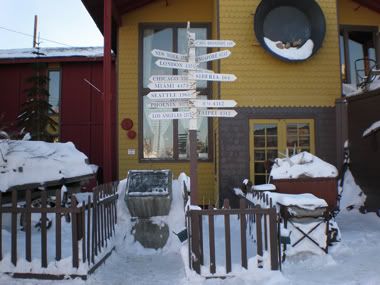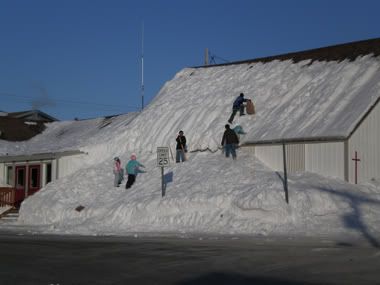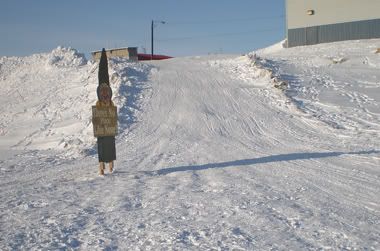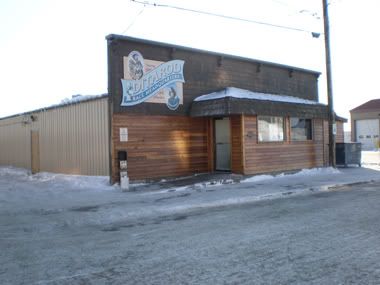
Written by Nancy Duresky
Wednesday, March 20, 2009
This morning at 6:30 am, I walked down to the finish line and stood in front of the Nome City Web Cam to wave at my teammates back at work. It was –8 degrees Fahrenheit. They logged on to the web site and could not see me. They described what they could see. Apparently, the city changed the angle of the camera for the race. When I got to the spot, under the burled arch, where the camera was pointing, they saw me standing and freezing. It was like we together had accomplished something! Apparently the city keeps a log of old web cam pictures. If you can figure out how to pull up that log, you can see me standing under the burled arch in the cold dark morning.
There was a half-second delay in our phone call. I spoke and then there was a pause until a teammate would speak back. This delay also happens on some television reporting from overseas. It is due to a satellite link. When a communication signal travels over land, even over land (under the sea) from Europe to the United States, or even the short distance from a cell phone to a cell site and then carried over land, there is no noticeable delay in the signal for the time it takes for the signal to travel from sender to receiver. However, there are no landlines to Nome. All communication travels through a satellite link. One of the city’s satellite dishes is located off of Front Street pointed at the horizon. The communication satellite that carries that signal is located 22,300 miles above the equator. Since they are located over the equator and Nome is located near the artic circle, the satellite dish is pointed at the horizon—unlike in a place like Hawaii where the satellite dishes are pointed almost straight up.

For the signal to travel that far to the satellite and back to earth takes a quarter of a second. Our human brain can notice that delay. The communication satellites allow all the communication to and from Nome to happen. It allows the city of Nome to be linked with the rest of the world, and it allowed me to talk to my teammates right under the burled arch. And most of those communication satellites were built in Southern California, actually, in El Segundo at the Satellite Design Center. Pretty cool.

This year, for the first time, mushers were tracked by GPS. Those satellites are located much closer to earth and there are many more of them. The signal among all the satellites allows the system to figure out the location of the musher. Race officials can track if a musher is moving or not and make a judgment if that musher needs help.
By the time I walked to the web cam, made the call, waved at my team, talked to a few people, I was freezing. Even with all those clothes on, the meat in my legs was cold. I was headed home and the siren went off. Every time a musher reaches the outskirts of Nome, the siren goes off. Who should be coming off the ice, but one of my most favorite mushers, Rick Swenson. He was traveling with another musher. Rick Swenson is the only musher who has won this race five times. He is 58 and still a strong musher. He looked good today – but then, even when he’s hanging out at race headquarters or eating at Freddie’s, he looks good to me. Down Front Street, his team looked happy and strong. One year, Rick and another musher, Dick Mackey, father of the current champion, were on Front Street together.
They were neck and neck the last ¼ mile of the race. After a 1,100-mile race, they were going to be tied for the championship. The crowd was cheering and screaming. Each musher was yelling encouragement to his team and pumping (standing on one runner and pushing with the other foot like a skate board.) They entered the chute at the same time, and then Dick Mackey’s team inched ahead and the nose of his lead dog crossed the finish line one second before Rick’s lead dog. As crazy as it happens, Dick’s sled got caught on the side of the burled arch and never crossed the finish line. Rick’s sled glided across the finish line first. Who won? The race begins with the front of the sled on the start line in Wasilla. Is it the sled that counts or the dog? Mushers can drop dogs, they can’t drop a sled. When asked what he thought, Rick said, “Who ever heard of a horse race being called based on a horse’s ass. The judges ruled that Dick Mackey won. And Rick is now a 5 time champion instead of a 6 time champion. Some people argue to this day about that call. Besides the horse’s ass comment, Rick does not talk about this race. It was the judges’ call and that’s that.
I don’t know if all the details are true. It’s how the story was told to me, however, I believe Rick is living out one of his creeds – you take life as it happens and you move on. You don’t keep living in the past. In my book, Rick doesn’t have to worry about being a six time champion, he is an all-time champion.
An interesting note, bib numbers are assigned by random drawing. All the numbers are put in a hat and each musher is called up and chooses a slip of paper with a number on it. That is his or her bib number. The race that Dick Mackey won by one second, it was his 6th attempt and he was wearing bib 13. His son Rick Mackey won the Iditarod on Rick’s 6th attempt wearing bib number 13. And the first time Lance Mackey won, it was his 6th attempt and he was wearing bib, you guessed it, 13.
Stay tuned for more from Nancy!




